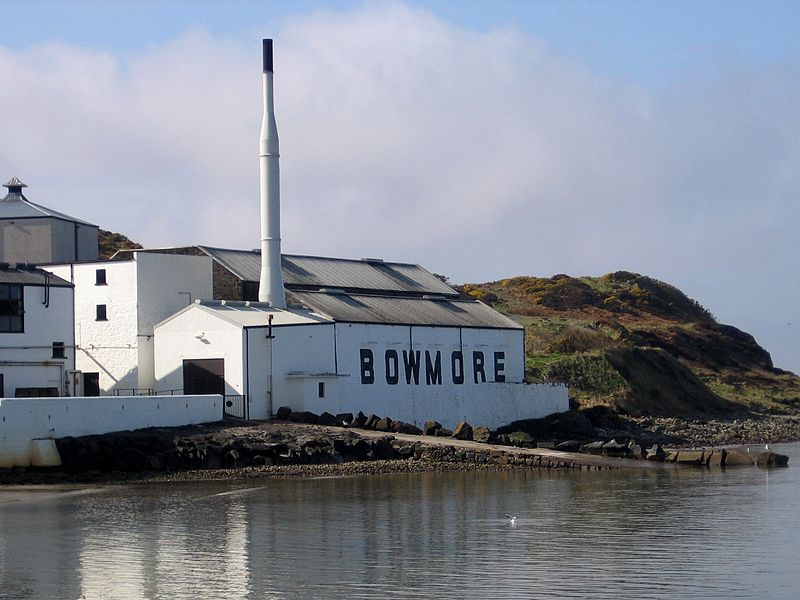Distillery of the Month – Bowmore
About the Distillery
Our Distillery of the Month for June is one of Scotland’s oldest, and the oldest of all Islay distilleries – Bowmore.
It was officially founded in the town of Bowmore, Islay’s capital, in 1779 by a merchant called David Simpson.
Simpson actually purchased the land on which the distillery was built in 1766, and many suspect that illicit whisky production began then, however there are no real records of this. As a result, what went on at the site between then and when the distillery acquired an official license some 13 years later, is still shrouded in mystery.
Early Days
David Simpson ran his distillery until he passed, at which point Bowmore was purchased by the Mutter brothers – William and James.
The Mutters were Glaswegians who descended from Germany, and James Mutter, the head of the family at the time, also had the rather lofty role of being the Vice Consul representing Portugal, Brazil and the Ottoman Empire through their Glasgow consulates.
It is safe to presume that his involvement in Bowmore had more to do with his interests in farming and whisky than it did with Scottish-Ottoman relations (after all, Bowmore, like many other distilleries, was established as a farming distillery).
Mutter brought a level of expertise and wealth to the distillery that it had simply not experienced under Simpson.
He brought new processes and methods that massively increased production, one of which was an innovative and expensive lade that draws water from the nearby River Lagaan. Rather amazingly, this is still used today.
The lade was probably James’ best contribution to the distillery, but it certainly wasn’t the biggest.
A Steam Ship and the RAF
Bowmore had always used locally farmed barley and coal in their whisky production, but the sheer amount of whisky the distillery was producing under the Mutters meant that they started to run short.
To get around this problem, they bought a steam ship to import these commodities from other parts of Scotland. This is one of the most talked about parts of Bowmore’s history and it goes to show the wealth and investment levels of the owners at the time.
After doing a serious amount of outstanding and innovative work on the distillery, economic depression, and the resultant drop in demand for whisky, forced the Mutters to sell Bowmore to J.B Sherriff & Co in 1887.
John Bell Sherriff then sold it on to Joseph Robert Holmes in 1892, before buying it back in 1925 and renaming it “Sherriff’s Bowmore Distillery”.
Unfortunately, World War 2 was on the horizon and in 1940 production ceased when the RAF Coastal Command set up base in the distillery buildings. They sent seaplanes from Loch Indaal on anti-submarine missions and the malting floor, warehouses and still rooms of Bowmore would make perfect living quarters for many of the pilots, navigators and engineers (though we’re sure keeping them away from the casks was a bit of a challenge!).
This was a contribution to the war effort that was probably not great for business at the time, but definitely something to be proud of today.
Modern History
After the war ended, J.B Sherriff continued to operate Bowmore until 1963 when whisky broker Stanley P Morrison Ltd purchased the distillery, renaming their company Morrison’s Bowmore Distillery Ltd in the process.
This would spell the beginning of a new era for Bowmore. Their popularity increased as demand for Scotch whisky grew and their outstanding single malts began to be recognised throughout Scotland and around the world.
The peated, spicy and fruity character of Bowmore whisky was unique. It was not quite as peaty and smoky as the spirit being produced in other South Islay distilleries such as Laphroaig, but had more of a kick to it than the likes of Bunnahabhain’s lighter peated drams.
These whiskies were seen as outstanding and they are still sought after today.
A Quick Shift in Character
Around the 1970s the character of Bowmore whisky shifted from this peaty, spicy and fruity spirit to a more floral kind that became famous because of its flavour similarities with Parma violet sweets.
Much like the sweets themselves, this whisky divided opinion and while millions of people still bought and drank it, many of them longed for the return of the spirit of the preceding years.
They weren’t to get their wish immediately, but at the start of the 1990s, around the time Suntory took full ownership of the distillery (having previously been a part owner), the character of the spirit being produced at Bowmore started to shift back to that of the old days.
Those that had a dislike for the ‘Parma violet’ whisky were jumping for joy and those that had liked it, well they weren’t too fussed either.
Traditional in every sense
Despite building steam ships to transport their barley, hosting the RAF Coastal Command, changing hands several times and going through a couple of style changes over the past 200 years, the Bowmore distillery has managed to remain relatively traditional throughout.
They have always malted their own barley on their in-house malting floor (where possible) and have always drawn water straight from the River Lagaan. Their stills were also traditionally short and pear shaped and this is something that they have stuck with throughout their history and (excluding the Parma violet era) this has resulted in continuously delicious spirit.
It is the combination of an ever-changing, interesting history, and the fact that the distillery has managed to remain traditional and continue to produce excellent spirit throughout, that makes Bowmore our Distillery of the Month for June.
In order to celebrate Bowmore we’re offering 10% off all of their bottles! Just enter the code “BOWMORE10” at the checkout. For our full range of Bowmore whisky, click here.



